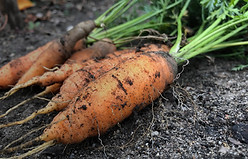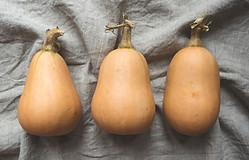Tips for the home gardener
Click these links to jump to information
Home gardens are an ideal place for Queensland fruit fly to live as they are warm and humid and provide food and shelter. Home gardens with many different fruit and vegetable varieties which ripen all year round are a haven for Queensland fruit fly populations to rapidly increase in numbers. Prevention is the best option.
Control strategies for homeowners need to be applied early and continuously after fruit set. Flies become active in mid-August as the weather warms up but will mate when the evening temperature reaches 16°C - and then start laying eggs.
Things to remember:
-
Once Queensland fruit fly eggs have been laid in your fruit it is too late to start control. This fruit needs to be disposed on immediately, click here for advice on how to dispose of infested fruit.
-
Be organised, have a plan, purchase your supplies and monitor fruit early.
-
Plan your garden to avoid Queensland fruit fly
-
Maintain good garden hygiene, keeping your garden clean and tidy helps break the life cycle of the Queensland fruit fly.
-
Protect your garden from Queensland fruit fly with exclusion nets.
-
Control Queensland fruit fly in your garden with, control devices, baiting or cover spraying.
1. Plan your veggie garden to avoid Queensland fruit fly - Why not try these options?
Plant vegetables in your garden that are not host fruits for Queensland fruit fly and will help avoid attracting flies to your garden.
Roots and bulbs
Beetroot, Carrot, Turnip, Parsnip, Potatoes, Garlic, Onion.
Leafy greens, stems, and pods
Lettuce, Cauliflower, Cabbage, Rhubarb, Broccoli, Asian Vegetables (Wombak, Bok Choy, Snake Bean) beans and peas.
Herbs and spices
Rosemary, Turmeric, Mint, Ginger, Basil, parsley etc.
Tough skin
Pumpkin, Watermelon, Cantaloupe, Squash, Cucumber, Corn






Are you still wanting to have Queensland fruit fly hosts in your vegetable garden?
If you still want to grow fruiting vegetables in your garden that are prone to fruit fly such as tomatoes, capsicums, chillies, and eggplants consider using an exclusion net. Consider the timing of applying nets to allow access to beneficial insects such as bees to pollinate the garden. See tip 4 for exclusion netting.
2. Remove trees that are prone to fruit fly attack, or consider down-sizing your crops
If you do not want to have to deal with fruit fly in your garden, consider doing the following:
Removing any unwanted or unmanageable host plants
If you have fruit trees in your garden that are prone to fruit fly attack and no longer wanted, consider removing the tree altogether and replace it with a non-fruiting tree. Consider how many trees to do need, how much fruit do you eat? Grow just enough fruit that your family can use.
Consider unmanageable trees that are very large and are difficult to properly manage for fruit fly. Please do not "leave fruit at the top of the tree for the birds". If you can’t reach all the fruit to pick it, Queensland fruit fly will infest the fruit you leave on the tree.
Keeping non-preferred hosts
If you still want some home grown produce, consider growing plants that are not preferred by fruit flies. Some citrus, especially those ripening in winter for example are less prone to Queensland fruit fly infestations. Don’t be complacent with these fruits as although they may not be a preferred host they will become infested if fruit flies are in high enough numbers and need to be managed to avoid infestations.
If you still want to grow some fruit and vegetables in your garden, consider:
-
planting less, so that you can concentrate your efforts on just a few crops
-
keeping only the crop plants and trees that you really want, remove the rest
-
pruning fruit trees heavily and thinning out fruiting buds
-
growing dwarf-sized varieties of fruit trees in pots for easier management
-
growing early fruiting varieties that fruit before fruit flies become a problem
Even with these considerations you will still need to practice good garden hygiene, protecting your crops using exclusion, control fruit fly in your garden.


3. Garden hygiene and sanitation
Keeping your fruit growing area at your home clean and tidy helps to break the life cycle of the Queensland Fruit Fly.
To practice good hygiene in your garden consider:
-
Reducing tree heights to make it easier to pick all the fruit.
-
Managing crop yields through thinning and trimming outside of the area being protected on the tree.
-
Picking fruit early.
-
Disposing of any fallen fruit, waste or unwanted fruit through deep burial, double bagging and placing in the sun for 2 weeks, slashing or mulching. Click here for more information on disposal.
-
Removing trees that are not being actively managed for Queensland fruit fly.
-
Removing all left over fruit after harvest and disposing of properly.
-
Keep an eye on ripening fruit for signs of Queensland fruit fly. All suspect fruit should be disposed of immediately and correctly

4. Exclusion netting - FACT SHEET
Creating a physical barrier between flies and your fruit with a fine meshed net is simplest way of growing clean fruit.
It is also one of the overall cheapest methods to control Queensland fruit fly in your garden. The price range for a proper insect net can be from $50 or more. The initial upfront cost might seem high, however this averages out over the life of the net. Insect nets are UV stabalized and repairable, therefore you can use them for multiple years.
Insect nets can be transferred from early fruiting varieties e.g. stone fruits in early summer to late fruiting varieties e.g. apples or pears in autumn. This also cuts down the cost as you do not need one for every tree.
Nets can be purchased from local nurseries or hardware suppliers or are available online.
The first step starts back in winter when it’s important to prune your trees to about 2 metres high and less than 2 metres wide. This helps the net fit over the tree and also prevents damage to the net. You may also need to prune the new growth at the top of the tree before applying your net.
Do not cover the tree until the fruit set. Allowing time for the beneficial insects such as bees to access and pollinate the flowers. Fruit fly can lay eggs into green fruit, so don’t leave it too late to cover your trees – generally 6-8 weeks before ripening.
The net must contain the whole tree and tied up around the trunk making sure there are no gaps for a fruit fly to enter. This can be accomplished by using string, electrical tape. If there are any seams that are open, they should be folded closed and fixed in place using clothes pegs.
If the net rests on any piece of fruit it is possible for the fruit fly to lay their eggs through the net. Care must be taken to either remove this fruit or reposition them in such a way that leaves or branches are between the fruit and the net.
The nets are reusable so make sure you repair any damage before putting them away in the shed ready for next season.
For more detail on how to apply your exclusion net download our information sheet.

5. Bait spraying
If you have a big garden, it might be worth considering applying a weekly bait spay.
A bait for Queensland fruit fly (contains a food attractant (protein) and a toxicant (insecticide). The bait mixture is applied as a low-volume spray onto tree foliage or bark. Queensland fruit flies are attracted by the protein in the bait. Insecticide mixed with the protein kills flies that feed on the protein. Using a bait, control is achieved with only a very small amount of insecticide, without applying any chemical to the fruit.
Bait is applied to tree bark or foliage as a coarse spot spray or as a band spray. Do not allow the bait to contact fruit. Bait Sprays need to be applied every seven to ten days (or as directed on the label) while there is fruit on the tree and for about three weeks after harvest.
Reapply baits after rain (>5mm) or if you use a sprinkler that can wash the bait away.
Always follow the directions on the label and make a fresh mix for each weekly spray as the spray may go off in the container.
There are organic bait spray options available. Contact your local agriculture supplier for information on bait spraying.
6. Traps and lures
Using traps and lures to suppress Queensland fruit flies is a popular method in home gardens. Traps and lures provide help in suppressing numbers but will not entirely stop Queensland fruit flies damaging your fruit. Use traps and lures in conjunction with other control methods.
Traps and lures only have a short range of attraction, about 30 metres. This means that it will not attract fruit fly from 'down the road' or from a long distance. If you catch anything in your traps it means that Queensland fruit fly was on or around your property.
Different traps and lures attract male or female flies so it is good to have a combination of both varieties.
There are a variety of commercially available traps and you can also make your own.

7. Cover spraying
A systemic insecticide can be purchased from your local agricultural supply store. These insecticide are sprayed onto the fruit. They can generally only be purchased in bulk amounts, which are not suitable for a home setting. The available options differ between fruiting varieties.
Withholding periods (the minimum period which must elapse between the last application of an insecticide and human consumption) varies depending on product and fruit variety.
Insecticide sprays can be harmful if used incorrectly. Advice should be sort from your local agricultural supply store and refer to label for directions for use. Fruit Fly Murray Valley cannot provide any advice on cover spray options.


8. Protecting your hard work
After all your hard work to control Queensland fruit fly in your garden it is important to stop re-infestation.
Consider the following:
-
Advise visitors and well-meaning friends and family not to bring infested fruit onto your property.
-
Remove unwanted fruit trees along driveways, wind breaks and nature strips.
-
Help neighbours to manage their fruit and vegetables.
-
Pick up any fruit you do not use.
-
Grow vegetables that don't host Queensland fruit fly.
-
Plough in vegetable gardens as soon as they have finished producing and making sure there are no Queensland fruit fly in any leftover fruit.
-
Remove flowers or developing fruit that you are not going to protect.
-
Pick and use fruit as it ripens
-
Before disposing of fruit, destroy any maggots.
Homemade traps
Homemade trap and bait recipes take just minutes to make with items you probably already have at home. They are an inexpensive way to suppress fruit fly in your garden.
The liquid in home-made traps attracts flies into the trap and then when the fly can't escape they drop into the liquid and drown.
Use 1-2 traps in and around each tree and replace the baits at least every 1-2 weeks, or if they become full of flies, or the liquid evaporates too quickly.
For detail on how to make your own trap and different recipes to try download our information sheet


